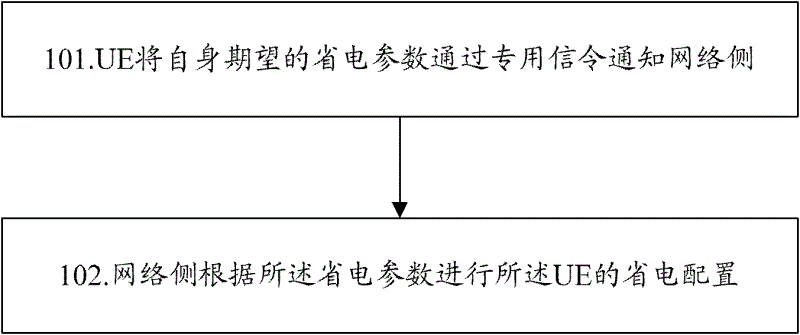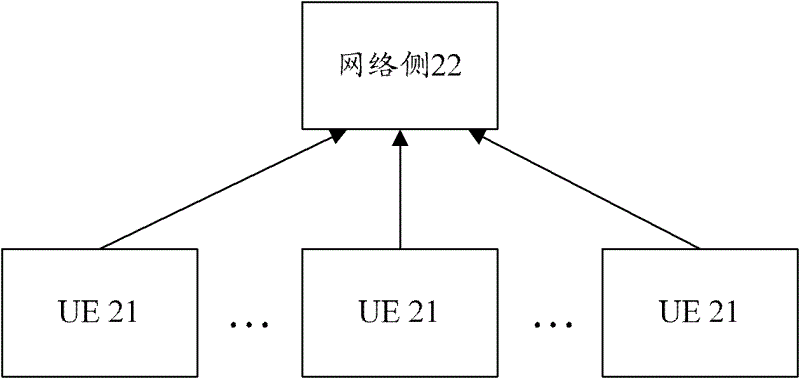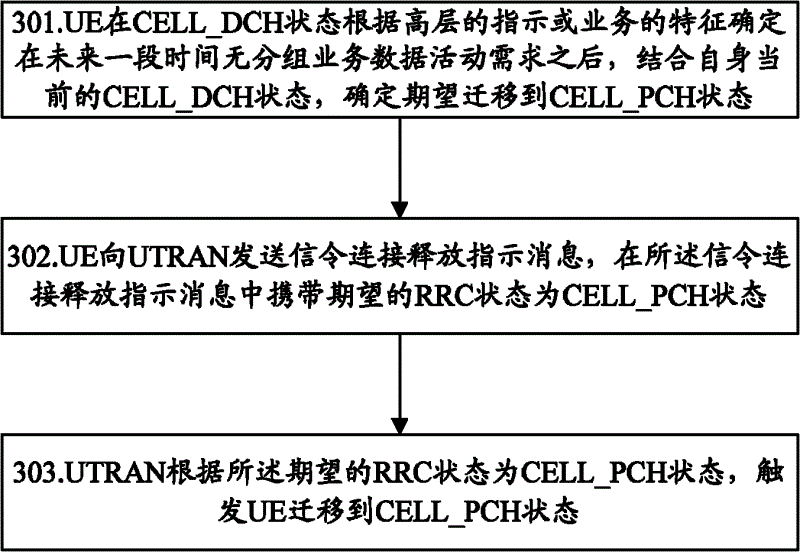Method of user equipment power saving and system of the same
A user equipment and power-saving technology, applied in the direction of electrical components, energy-saving ICT, advanced technology, etc., can solve the problems of not being able to help the network configure DRX parameters UE, not being able to maximize power-saving efficiency of UE, and achieve a balance between service delay and power-saving efficiency , Improve power saving efficiency and the effect of flexible power saving mechanism
- Summary
- Abstract
- Description
- Claims
- Application Information
AI Technical Summary
Problems solved by technology
Method used
Image
Examples
Embodiment 1
[0071] In the UMTS system, the UE informs the UTRAN that it expects to transfer the RRC state from the CELL_DCH state to the CELL_PCH state, such as image 3 As shown, the implementation of the UE power saving method in this embodiment includes the following steps:
[0072] Step 301: After the UE determines in the CELL_DCH state that there will be no demand for packet service data activities for a period of time in the future according to the instructions of the high layer or the characteristics of the service, it determines that it expects to migrate to the CELL_PCH state in combination with its current CELL_DCH state;
[0073] In this step, the high layer refers to the application layer or the non-access layer (NAS);
[0074] This step further includes: when the UE determines that there will be no need for further packet service activities after a certain period of time during the packet service activity, setting a delay time for transitioning to the CELL_PCH state.
[0075...
Embodiment 2
[0082] In the LTE / LTE-A system, the UE uses the newly added signaling connection release indication or reconfiguration message, or other existing RRC messages to carry its own desired power saving parameters, such as Figure 4 As shown, the implementation of the UE power saving method in this embodiment includes the following steps:
[0083] Step 401: After the UE determines in the RRC_CONNECTED state that there will be no packet service data activity requirements for a period of time in the future according to the instructions of the high layer or the characteristics of the service, it determines that it expects to migrate to the RRC_IDLE state in combination with its current RRC_CONNECTED state, or short DRX cycle, or DRX parameters , or switch to a long DRX cycle, or reconfigure DRX parameters;
[0084] In this step, the high layer refers to the application layer or NAS;
[0085] This step further includes: when the UE determines that there will be no need for further pack...
Embodiment 3
[0102] In the UMTS evolved multi-carrier system or the LTE-A carrier aggregation system, the UE uses existing or newly added signaling connection release or reconfiguration messages, or other existing RRC messages to notify the network side of its desired carrier aggregation configuration information, For example, deactivate or configure one or more secondary cells or secondary carriers, such as Figure 5 As shown, the implementation of the UE power saving method in this embodiment includes the following steps:
[0103] Step 501: UE in the CELL_DCH of UMTS or RRC_CONNECTED state of LTE-A determines the desired deactivation and / or based on its current carrier aggregation configuration after determining that there will be no packet service data activity requirements for a period of time in the future according to the instructions of the high layer or the characteristics of the service Or to configure at least one secondary cell or secondary carrier;
[0104] In this step, the h...
PUM
 Login to View More
Login to View More Abstract
Description
Claims
Application Information
 Login to View More
Login to View More - R&D
- Intellectual Property
- Life Sciences
- Materials
- Tech Scout
- Unparalleled Data Quality
- Higher Quality Content
- 60% Fewer Hallucinations
Browse by: Latest US Patents, China's latest patents, Technical Efficacy Thesaurus, Application Domain, Technology Topic, Popular Technical Reports.
© 2025 PatSnap. All rights reserved.Legal|Privacy policy|Modern Slavery Act Transparency Statement|Sitemap|About US| Contact US: help@patsnap.com



